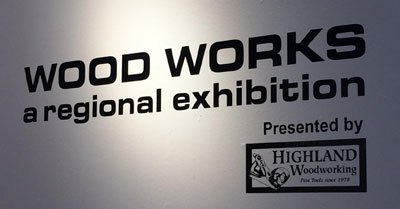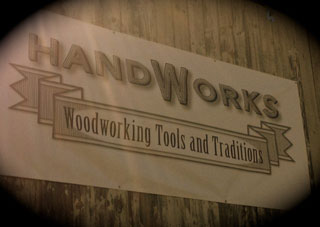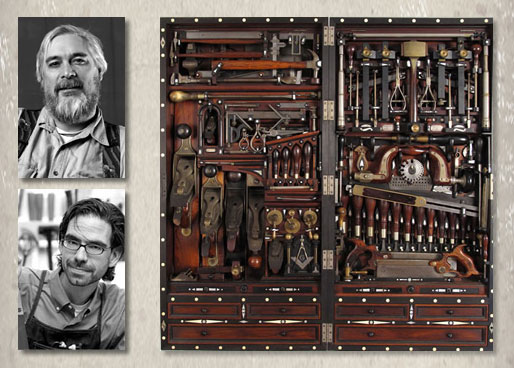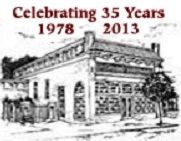Highland Woodworking and Gary Rogowski’s Northwest Woodworking Studio have partnered together to help make woodworking education more available for everyone.
Gary is offering a FREE 2-hour online seminar on Saturday, Sept. 28 at noon ET that will discuss his Online Mastery Program, give a quick tour of the curriculum, show images of design work from graduate students and he will answer any and all questions about the program.
Email Gary at studio@Northwestwoodworking.com to receive the Zoom link for the seminar.
You can read Gary’s latest newsletter at:
https://northwestwoodworking.com/newsletter/i-get-it/
Resawing is the term for woodcutting that takes a board of a given thickness and slices it into two or more thinner boards. Though it can be done on a small scale on a tablesaw, the bandsaw is universally regarded as the go-to tool for resawing lumber.
We recently stumbled across an old article from the now-extinct magazine American Woodworker* that addressed the question of how to select a good resawing blade for your bandsaw. Resawing has always been a favorite subject of ours here at Highland Woodworking, as our Wood Slicer Resaw Bandsaw Blade has been a best seller for us these past 30 years.
The article analyzed the most important features that help determine the performance of a resawing blade, namely blade thickness, blade width, number of teeth per inch, tooth form and durability.
 The article applied this analysis to the major brands of resawing bandsaw blades available, with emphasis on the accuracy of the cut as measured by the straightness and smoothness of the workpiece after it has been resawn. Of all the blades tested, only two brands of resawing blades met the necessary criteria set by the magazine’s editors. Spoiler alert: the Wood Slicer was one of them!
The article applied this analysis to the major brands of resawing bandsaw blades available, with emphasis on the accuracy of the cut as measured by the straightness and smoothness of the workpiece after it has been resawn. Of all the blades tested, only two brands of resawing blades met the necessary criteria set by the magazine’s editors. Spoiler alert: the Wood Slicer was one of them!
If you’re wondering how to successfully use your bandsaw for resawing lumber, reading this article may be helpful. If you’re interested in finding out more about the Wood Slicer or purchasing your own, you can do so on the Highland Woodworking website.
*Note: American Woodworker magazine was later absorbed into Popular Woodworking magazine.
More on resawing:
A Practical Guide to Successful Resawing
 Highland Woodworking’s friend, woodworker and professional actor Nick Offerman has a break-out leading man role in the new feel-good movie Hearts Beat Loud that opened on June 8. The movie reached Atlanta June 21, and the enthusiastic reaction here validates the movie’s many positive reviews. Support Nick and the cast’s other stars (Kiersey Clemons, Ted Danson et al) by taking someone you love to enjoy this inspiring movie.
Highland Woodworking’s friend, woodworker and professional actor Nick Offerman has a break-out leading man role in the new feel-good movie Hearts Beat Loud that opened on June 8. The movie reached Atlanta June 21, and the enthusiastic reaction here validates the movie’s many positive reviews. Support Nick and the cast’s other stars (Kiersey Clemons, Ted Danson et al) by taking someone you love to enjoy this inspiring movie.
Read more about Nick Offerman’s recent visit to Highland Woodworking

If you are within driving distance of Athens, Georgia, don’t miss the opportunity to visit this delightful woodworking exhibition that is open Tuesday thru Saturday, 10 AM to 4 PM thru Friday, Feb. 17, 2017 at the Oconee Cultural Arts Foundation in Watkinsville, GA.
CLICK HERE to see a photo gallery from the exhibition
Highland Woodworking is honored to be the presenting sponsor of Wood Works, a first-year exhibition that showcases a wide spectrum of woodworking with over 100 pieces by 35 southeastern artist craftsmen. Retired University of Georgia professor Abraham Tesser is the event’s curator.
CLICK HERE for additional info on the exhibition
A Statement from the Exhibit’s Curator, Abraham Tesser
Wood is a medium that has been appreciated by mankind since the discovery of fire and the first use of tools. We still use wood to make fires and tools, but along the way we have come to appreciate this medium in many different ways. And that is what the show is about: The appreciation of wood. I have tried to present you with a broad swath of wood objects that I hope will compel your interest and delight.
The Southeast has an abundance of talented artists working in wood. But what they love about the medium varies widely across artists. Many artists are attracted to the beauty in wood that is revealed as lumber is sliced from the tree. Often a slab of wood or a thin slice of veneer reveals a palette of colors or an interesting grain pattern; or, reflecting the irregular growth of the tree, an interesting overall shape. Several pieces in the show feature such beautiful lumber; several showcase the rare beauty of exotic veneers. Even tree branches that we are likely to ignore, discard or casually drop on the fire can be fashioned into beautiful, interesting and functional pieces of furniture. Some artists are concerned with preserving the environment and use reclaimed or salvaged wood. Age, weather and usage often give wood (and us!) a special character that enhances the interest value of pieces constructed from it.
Other artists are attracted to wood because of its properties as a medium. Not only is wood warm and beautiful, it is also relatively light, durable and easy to shape, sculpt or turn. What a wonderful material in which to express one’s own vision. And, those artistic visions in wood go from the functional to the whimsical to the purely esthetic. Artists differ in their favored approach to processing wood. There are turners, sculptors, and joiners. They work in solid wood and wood composites. Their work appeals to your brain and to your eye. And, if a piece has soft curves and is finely finished, it appeals to your hand; it is very difficult to resist running your hand over such a piece. (In this venue I hope that you will resist this urge!)
So this is the show. Pieces of wood that have been skillfully, artistically transformed into the objects before you. Have these objects engaged you, captured your interest, piqued your curiosity or perhaps even delighted you? To the extent that they have, our efforts have been successful.
CLICK HERE to see our other write-up of the event with reviews from local media organizations.
We attended part of British woodworking teacher Graham Blackburn’s class titled “5 Favorite Hand Tool Appliances.” Graham made a convincing case that hand tools need not be used merely freehand. In fact with some simple preparation he demonstrated using hand tools to cut accurately without even using his eyes.
 Some takeaways from the class:
Some takeaways from the class:
1. Avoid measuring. Instead transfer dimensions directly from the workpieces that are to be fitted together.
2. Avoid cutting freehand. Example: use a one-bevel marking knife to scribe your cut line, then use the vertical wall of the cut line as a “fence” for your saw blade.
3. Take advantage of what your body can do best, e.g. place the workpiece vertically in your vise to make it easier to saw accurately; place 3 fingers on the saw handle so the index finger points in the direction of the cut; in general position yourself and your stance to your ergonomic advantage.
Graham considers the try square to be a woodworking jig, not an actual tool. (To him, a woodworking tool is something that cuts wood.)
His first 3 favorite “hand tool appliances” are the bench hook, shooting board, and winding sticks, all of which he strongly believes a woodworker should build for themselves, since after all, they are made out of wood. When told by someone in the audience that artisan wooden winding sticks were being offered for sale in the show’s marketplace for $95 a pair, he laughed and said “Isn’t America great!”
We moved on to sample another class before he named his final two favorite jigs. He does have a new book out that covers that and much more:
Jigs and Fixtures for the Hand Tool Woodworker

Chris Bagby, owner of Highland Woodworking, flew from Atlanta to Cedar Rapids, Iowa last weekend to attend the first ever Handworks, a woodworking show that was all about hand tools. Below is his description of the event, and here is a link to an interesting photo tour of the Handworks show.
For what seemed like was going to be a fairly small event, the crowd waiting outside the Amana Colony’s “Festhalle” barn was quite large and enthusiastic. And here we were out in the middle of nowhere, so to speak, on a Memorial Day weekend.
The crowd’s enthusiasm was a testament to the revival of interest in hand tool woodworking. (As Roy Underhill likes to call it, “Woodworking beyond the Norm.”)
The event was organized by the owners of Benchcrafted, a specialty manufacturer of fine workbench vises. Jameel Abraham is the technical wizard of the operation, and his brother Father John Abraham leads the business end of the enterprise.
The event’s venue was a very large old barn. Large as barns go, but not all that large by woodworking show standards. The crowd quickly filled the aisles between 3 rows of vendors and it became a challenge just to turn sideways. Demonstrations were underway at every exhibitor stand. The Lie-Nielsen Toolworks exhibit occupied all the space on an elevated stage on one end of the barn. Lee Valley and Veritas anchored the other end of the barn.
Between were a couple dozen exhibits staffed mostly by, well, woodworkers who had turned their interest to tool making. Also on hand was the Lost Art Press, who unveiled their newest book title, By Hand and Eye, written by Geo. R. Walker and Jim Tolpin.
For 2 days I made the rounds, getting reacquainted with several vendors with whom Highland Woodworking has been doing business over the years, as well as meeting quite a few new people whom I’d not met before. Among them were a number of Highland customers who all seemed to have pleasant stories to tell about shopping with us online or otherwise over the years. And there were several vendors whose wares I am very interested in and hope to add to our product line soon.
It was my first time to chat for a while with Robin Lee, President of Lee Valley Tools of Canada. I have always had a fondness for this company. They started in 1978, the same year that Sharon and I founded Highland Hardware. I especially admire Rob’s father Leonard Lee, whom I consider to be a modern-day Renaissance Man. Leonard pretty much retired from Lee Valley years ago, but at age 87 is still going strong with various activities. (Oops, Leonard just called to tell me that he is, ahem, 74, not 87. I am happy to stand corrected!)
I also enjoyed meeting Joel Moskowitz, owner of Tools for Working Wood in New York, another competitor of ours. Joel manufactures the Gramercy line of woodworking tools. Although I tried, I was not able to talk him into selling me a hundred of his unique bench holdfasts for us to sell.

On Saturday morning a standing-room-only crowd watched and listened as Chris Schwarz and Don Williams presented an excellent slideshow about the extraordinary tool chest of Henry O. Studley, an organ and piano maker who lived from 1838-1925. Both the chest itself and the array of tools it contains are spellbinding. The chest is made of mahogany, rosewood, walnut, ebony, and mother of pearl. Tools and chest together are reckoned to be worth “in the low 7 figures.” Lost Art Press will be publishing a book about the chest in the near future. By the way we sell a poster depicting the tool chest at the Highland Woodworking website.
It’s not known whether Handworks will become an annual event. Someone said they plan to repeat every two years, which seems to me like a good plan. I’m not sure the old barn will hold all the attendance that’s likely to show up in 2015 though. This was truly a unique event, far more down-to-earth than any other woodworking show I’ve ever attended.
— Chris Bagby
 ON A BRIGHT SPRING MORNING in the spring of 1978, Chris and Sharon Bagby opened the doors at Highland Hardware for the first time. Now 35 years later, they’re still in business operating the store that grew to become Highland Woodworking as we know it today. It’s been a long journey that could not have been accomplished without the support of countless thousands of loyal customers, many of whom have shopped here almost from the beginning.
ON A BRIGHT SPRING MORNING in the spring of 1978, Chris and Sharon Bagby opened the doors at Highland Hardware for the first time. Now 35 years later, they’re still in business operating the store that grew to become Highland Woodworking as we know it today. It’s been a long journey that could not have been accomplished without the support of countless thousands of loyal customers, many of whom have shopped here almost from the beginning.
Throughout these 35 years there have been many exciting additions and changes, but one thing has always remained the same and is our mission to deliver fine tools to your door.
Here is a timeline history of some milestone events that have happened over the past 35 years!
May 15th, 1978: Owners Chris and Sharon Bagby open Highland Hardware at 1034 North Highland Ave (across the street from its current location), an ordinary hardware store in Midtown Atlanta.
1980: The company begins to offer a weekend seminar program in their basement, bringing in woodworking masters like Tage Frid, Sam Maloof, and Roy Underhill.
1984: The store moves to a larger retail space across the street at 1045 North Highland Ave (and its current home today). The seminar program moves to a warehouse located behind.
1992: Our product-oriented newsletter, Wood News, merges with our woodworking tool catalog, and comes out 2-3 times per year as a physical publication. Our catalog is still published to this day, which you can subscribe to receive by mail HERE.
1995: The building is renovated to add 8,000 square feet to the store, which includes a brand new seminar/classroom space, a larger shipping/receiving area including a loading dock, a larger back office space, and additional floor space for retail sales.
1996: Highland Hardware launches into the World Wide Web at www.highlandhardware.com.
2005: Wood News begins as a monthly email newsletter with tools, tips, and monthly features highlighting woodworkers from around the world. Subscribe to Wood News HERE.
2006: Highland Hardware becomes Highland Woodworking. Still under the same ownership and still offering the same great service, we wanted to present a truer reflection of the nature of our tool offering and our position in the woodworking industry.
2013 (Present Day): Chris and Sharon are still involved in the everyday operation of our store and with a highly knowledgeable staff we are continuing to deliver fine, quality tools to your door.
As always, with passing years comes even more additions and technology. We invite you to continue checking out all of our new and exciting offerings by continuing to follow our Blog, like us on Facebook, tweet us at Twitter, hang out with us on Google+, or pin your favorite tips and tools on Pinterest.
From the entire Highland Woodworking family, we thank you for your continued support!
Sincerely,
Chris Bagby, Owner
